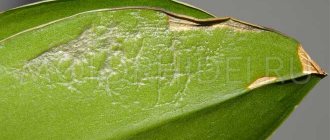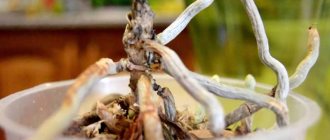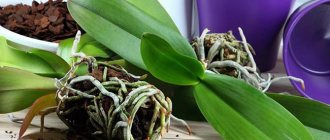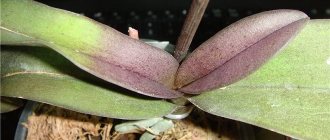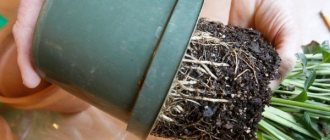How to revive an orchid? A similar question is usually asked by beginning flower growers who, out of ignorance or inexperience, have flooded the plant with water, which leads to rotting of the root system, or have minimized watering to such an extent that the flower has dried out. The question arises, is it possible to do something at home to breathe life into the orchid? Let's figure this out. Basically, it all depends on the specific situation. You need to understand exactly what happened to the plant, and then choose the right algorithm for solving the problem, if the flower can be saved at all.
Note! The most dangerous period for orchids is considered to be autumn-winter. This is explained by a drop in temperature outside, which leads to the need to turn on the heating system or appliances at home. This, in turn, leads to a decrease in air humidity and an increase in room temperature. Lighting also has its influence, which in winter is usually somewhat worse due to the fact that there is less daylight.
But in the warm season, orchids feel great. They can easily tolerate the absence of lighting, changes in humidity, and temperature changes. As a result, the grower must respond in a timely manner to the changing season and adjust the care of the plant, maintaining optimal conditions.
Causes of orchid wilting
The reasons for orchid wilting at home vary greatly. Typically, a grower notices that something is wrong with a plant when he notices limp leaves. Moreover, keep in mind that if only the lower leaves wither, and the upper ones are healthy and have a dark green tint, then everything is in order. If the vegetative mass withers both above and below, this is a cause for concern. If you do not begin to correct the situation, the leaves will quickly turn yellow, fall off, and the plant itself will die. In other words, if you notice leaf wilting, immediately look for the cause.
The main causes of wilting include the following:
- Overheat. It is usually observed if the flower is kept in a room with high temperature. Overheating can also result from direct sunlight on the plant, which leads to rapid loss of moisture. As a result, the leaves wither and eventually dry out. There is a basic method for solving the current situation. First you need to remove the plant to a dark place and keep it there for two to three hours. After “resting” in the shade, you can buy an orchid and spray the leaves. You should not expect that the ochidea will immediately come to life, since this requires at least two to three days, or even more, depending on the degree of wilting. Do not forget to take care of suitable growing conditions for the plant to prevent the situation from reoccurring in the future.
- Excessive or insufficient watering. In the first case, the problem is the high humidity of the substrate in the pot, which leads to rotting of the root system. Lack of moisture, on the contrary, causes the roots to dry out. To correct the situation, you will need to resuscitate the orchid (if possible), and then follow the care recommendations.
- The amount of fertilizer used. It is necessary to monitor how much fertilizer is used. Particular attention is paid to the proportions of substances (nitrogen, potassium, phosphorus and other microelements) necessary for the orchid that are contained in the fertilizer. In some cases, a flower dies from an excessive amount of bait, because the roots are poisoned. The disease manifests itself in wilting and yellowing of leaves, discoloration of roots and their rotting. Below is information that will tell you what to do if the root system has rotted. There is almost always a chance to “revive” a plant that seems hopeless.
- Parasites and harmful insects in the soil. The most common parasitic beetles are called click beetles. They feed on the roots of the plant. Treatment involves washing the roots with warm running water, treating them with pest repellents and replanting the plant in a pot with a new substrate. In the photo you can see what the larvae of click beetles look like.
Advice! It is advisable to give preference to small and elongated pots for growing orchids. In such containers, the substrate will dry out better between waterings, which means that the likelihood of root rotting will be minimized.
Do I need to remove the peduncle?
The orchid peduncle develops successfully and forms the buds of a healthy plant due to the roots and leaves :
- But if everything is not in order with them, then they cannot ensure full development of the peduncle;
- Experts advise cutting off the peduncle, depending on the condition of the orchid itself. But only the apical part;
- A reanimated orchid needs strength to restore its roots and leaves. Then the flowers will grow;
- But the plant may die. If he cannot cope with the provision of a peduncle. You decide.
How to properly revive a plant?
How to properly revive a plant with rotten, frozen or dried roots? You can almost always solve a problem, even if the case seems hopeless. It will be possible to correct the situation if the plant was flooded, found frozen (the plant must be allowed to thaw at a temperature below room temperature, and then begin resuscitation) or dried out. The algorithm is always the same. However, the sooner a problem with the root system is noticed, the greater the chances of successfully resuscitating the flower. First you need to examine the orchid to assess the extent of the damage. To do this you need to pay attention to the roots:
- Healthy roots are quite fleshy, dense and elastic.
- Their color depends on the age of the flower: young ones are light green, old ones are gray or brownish. If the plant has not been watered for a long time, the root system will be almost white, and after watering it will be rich green.
- If the roots are feeding the plant, they will be smooth, hard and dry.
It is most convenient to examine the roots by removing the substrate and washing the underground part of the plant. So, the following will indicate rotting:
- Darkening of the root system.
- When you press on the root, liquid will flow.
- The roots have a collapsed and thread-like appearance.
- There are slimy and wet areas on the root system.
Note! Dried roots will be noticeable immediately. They will become dry and brittle.
Rotten and dried roots cannot be saved. They need to be cut using a sharp, disinfected device. You need to trim so as to capture a small part of healthy tissue. Pruning will not affect the viability of the plant, which will be properly cared for in the future.
Next, you need to process the sections using ground cinnamon or crushed activated carbon. Any of these products has disinfectant properties. Then leave the roots to dry. After this, you can immerse the root system in the fungicide solution for about 10-15 minutes to protect the plant from damage by harmful fungi. Healthy areas are treated with growth stimulants to accelerate the growth of the root system and increase immunity to diseases.
Prevention measures
Prevention of rotting of orchid roots involves creating suitable conditions for the development of the plant. The planting container must have drainage holes at the bottom and in the side walls. This ensures air access and excess moisture drainage. After watering, the liquid must be allowed to drain completely until the pot is placed in a pot or on a tray. The watering schedule should be planned based on the appearance of the root system and its condition.
Only by following the rules for keeping orchids can you eliminate rotting processes or save a plant that has already suffered.
Orchid left without roots
What to do if the orchid has dried out or rotted and is left without roots? This question arises for those gardeners whose plant has lost almost its entire root system. Even in this case, there is a chance to restore the plant with proper care and patience. There are three main methods of revival:
- Using a greenhouse.
- Through regular watering and drying.
- Using an ordinary substrate.
It is very important to choose the most effective method. First you need to assess the condition of the plant. The duration of rehabilitation depends on this. On average, a flower that has lost up to 60% of its root system will need at least one month to recover. But a plant that, for any reason, has lost 90% or more of its roots will recover within eight to twelve months. In any case, it is very important to ensure proper maintenance and care.
So, what to look for when choosing a method to save an orchid? Consider the condition of the affected color, the number and condition of the remaining leaves, the presence of root primordia formed in the lower part of the leaf rosette (without this growth point, resuscitation will be more problematic). It is also worth paying attention to the conditions that the grower can provide for the orchid during the period of resuscitation.
Reanimation of a flower in greenhouse conditions
Resuscitating a flower in greenhouse conditions is considered the simplest and most effective. A florist will need a windowed greenhouse where he can achieve comfortable temperatures and high humidity on a constant basis.
In principle, the procedure for resuscitating a plant is simple:
- You need to take a container in which the flower will be rooted, and first pour a thin layer of expanded clay into it, and then cleaned sphagnum moss (it is advisable to steam it first).
- Then you should place the root rosette in the prepared container and install it in the greenhouse.
Note! In the greenhouse, it is necessary to maintain humidity in the range of 70%-100%, temperature from 22 to 28 degrees (temperatures below 20 and above 33 degrees will lead to the fact that root growth will be suspended, and the proliferation of fungi and pathogenic flora will occur quickly), bright and diffused lighting for 12-14 hours a day on an ongoing basis until the flower has formed roots at least 3-5 centimeters long.
This method is suitable even in cases where all the roots of the orchid have rotted. Monitor the condition of the plant after carrying out the above-described manipulations. If necessary, the greenhouse must be ventilated and the substrate moistened. It is advisable to do this at night. The purpose of the procedure is to saturate the air with carbon dioxide and accelerate the formation of the rudiments of a new root system of flowers.
The success of the procedure depends on many factors, including maintaining the required conditions. At the same time, regularly inspect the plant to get rid of pockets of rot when they first appear.
With proper care, the first roots will appear after 10-14 days. You can transfer the orchid to its usual conditions (plant it in a pot with a substrate and remove it from the greenhouse) no earlier than roots 3-4 centimeters long have formed.
Resuscitation using watering and drying
Resuscitating a house with the help of watering and drying is quite possible. This method is suitable for those gardeners who do not have a greenhouse. You will need a deep glass vessel into which you need to place a pre-treated (trimmed from rotten roots and with treated cut areas) leaf rosette. Every day you need to pour water into the container (necessarily soft, filtered or boiled), and so that the outlet only touches the water, and the leaves remain unaffected.
The plant is left in this form for six hours. Then the water is drained and the flower is left to dry until the next morning. Then the procedure is repeated.
Advice! You can make sweet or honey water for faster formation of new roots. To do this, you need to dilute one teaspoon of honey or one tablespoon of sugar in one liter of water.
Additionally, it is useful to use the following tools:
- complex fertilizers, but they should be used in low concentration;
- preparations with a high iron content for feeding;
- growth regulators for monthly treatment.
Revitalizing an orchid by planting it in a substrate
Reviving an orchid by planting it in a substrate is an alternative method that can be used if the plant has not lost all its roots, but only part of them. A distinctive feature is the ability to feed the flower in the usual way. The missing roots can be grown by planting the plant in a pot.
The diameter of the container should be about 6-8 centimeters. You can use an ordinary substrate in which all orchids grow. But it must be fresh. It is imperative to maintain the temperature in the range of 22-25 degrees and lighting for at least 12 hours a day. In this case, it will be possible to activate root growth. Remember that even at night you cannot reduce either the temperature or the humidity (it can even be increased a little) so as not to slow down the formation of the root system.
The plant cannot be watered; it can be irrigated, and only the top layer of the substrate. You can also place the orchid pot in a tray with a small amount of water. The next moistening of the soil is carried out after complete drying. New roots will begin to appear 2-4 weeks after resuscitation begins.
Success and timing of resuscitation
The success of your efforts will depend on the following factors:
- How viable is the plant itself: the more it is destroyed, the less chance there is.
- Have you followed all the recommendations: a mistake in one action will bring everything to naught.
- Choice of time of year: in the spring, the plant will recover faster and more successfully.
- If you are reviving an orchid in winter, the success of your enterprise will depend on whether the orchid has lighting.
You shouldn't expect very quick results. But if you did everything correctly, then in a month the first roots will appear on the neck of the plant. Leaves begin to grow no earlier than after a month and a half. Complete restoration of the orchid will take approximately 8-9 months.
Caring for an orchid after “revival”
Caring for the orchid after “revival” is very important. It guarantees that the plant will fully recover and will soon delight you with the appearance of flowers. The rules are simple. It is enough to follow these recommendations:
- You need to water the plant very carefully. It is advisable to use the method of irrigating the top layer of the substrate or pour water (a little) into the pan and place the pot with the plant in it for 20-25 minutes.
- It is better to refrain from feeding for at least one month after “revival”, so that the flower does not react negatively to the fertilizer. Next, you can introduce fertilizing in small quantities. If you notice darkening of the roots, wilting of flowers or dulling of leaves, stop using fertilizer immediately. Such symptoms indicate poisoning or burns of the root system.
- During watering, you can monitor whether there are pests on the plant. When the root system is moistened, they will crawl up the stem. If they are detected, you need to change the substrate in the pot and treat the roots of the plant with a fungicide.
- The health of an orchid depends on the quality of the substrate. Use only good and not too dense soil so that the plant feels comfortable and problems are eliminated in the future.
- Maintaining comfortable conditions: temperature in the range from 22 to 25 degrees, humidity at 30%-40%, lighting for at least 10-12 hours every day.
- Inspect the plant regularly to prevent diseases, pests, rot and other problems.
Remember! Neither fertilizers nor growth preparations should be used during the recovery period of the orchid after damage. This can lead to the root system of the flower being poisoned.
External signs
You can guess that the roots of an orchid are rotting by the appearance of the leaf blades. The leaves become limp and soft, lose their elasticity. After a short time, yellowing begins and the leaves dry out.
When you touch a diseased plant, you may feel that it is staggering or leaning to one side. So, it occurs due to the loss of the root system. A healthy plant has roots that securely hold it in the ground.
The condition of the roots can be assessed visually through the transparent walls of the pot. They become dark and dry. Sometimes, on the contrary, you can notice that the roots have begun to rot and are covered with characteristic spots. At the same time, the aerial roots dry out and become brittle. Deciding what to do with an orchid if it has yellow roots must be done after a thorough examination and determination of the cause of the problem.
How to resuscitate a child who is dying?
How to resuscitate a child who is dying? Ideally, the baby should be separated from the mother specimen when roots have formed at least two to three centimeters. If the baby’s roots are not formed, then it will be problematic for her to survive. But you can always try. To do this, you can do this in the following ways:
- Using a greenhouse. Detailed instructions are given above. The only condition is daily watering of the sphagnum.
- Stimulate growth by watering and drying daily. Above is an algorithm explaining how to do this correctly.
In any case, it is advisable to first soak the baby in any growth accelerator (stimulator).
The most popular growth stimulants (drugs responsible for activating the growth of the root system and increasing plant resistance to diseases) include:
- Store-bought products, for example, “Zircon” or “Epin”. Any of the drugs is diluted on the basis that one drop of the product is enough per liter of water. You need to soak the plant in the resulting solution and leave it for from twenty minutes to two hours, depending on the degree of damage to the roots.
- Succinic acid. It does an excellent job of stimulating the growth of plant roots. It also helps to increase vegetative mass. The product is diluted on the basis that one tablet of acid is needed for one liter of water. The resulting solution can be watered or sprayed on the flower, but not more than once a month.
- "Fitosporin". This drug is recommended for use if the cause of plant wilting was a fungal disease. The instructions for the drug indicate how to properly dilute the product. You need to soak the flower in the resulting solution for 15-20 minutes. Next, plant it in a substrate or greenhouse.
- Cytokinin paste. It activates growth, improves metabolism, promotes the appearance of buds and flowers on the plant. You need to dip a toothpick into the paste and treat the plant buds and root sections. Apply the product in a thin layer so that the plant does not get burned.
- "Kornevin". The drug is recommended for phalaenopsis orchids, which are very common among gardeners. The product must be diluted according to the instructions indicated on the package. Next, the roots of the plant are placed in the solution and left for up to twenty minutes. The result is a strengthened immune system, increased vitality and an increased ability to recover more quickly.
Remember that you first need to familiarize yourself with how to resuscitate an orchid, decide on the method preferred in a particular case, and then begin the procedure. This will guarantee that everything will be done correctly, which means that the flower will be able to be revived and will delight in blooming again. Below you can find a video that details how to resuscitate an orchid at home.
Features of foliar feeding
Alternate foliar feeding root feeding:
- Hold them in the evening;
- Experts recommend using Doctor Foley Orchid;
- Before spraying the leaf, slightly moisten the substrate;
Succinic acid is often used for foliar feeding. - Regular succinic acid is often and effectively used for roots. Flower growers recommend wiping the leaves (top and outside) with a cotton swab. Pre-moisten it in succinic acid dissolved in water.
One tablet per glass of water . To increase immunity in plants.
Withered leaves
Is it possible to keep an orchid at home: options why it’s good or bad
When you have managed to grow the roots of the orchid, you can plant the flower in a pot with soil. However, there are situations when the leaves of a plant begin to wither and they stop holding their shape.
Loss of leaf turgor
How to save an orchid without roots and with limp leaves:
- Start growing roots.
- If there are rotten parts of the leaf, they should be cut off and the sections treated with charcoal, brilliant green or cinnamon. Then dry for about eight hours.
- Create conditions for regeneration and revitalization of the flower.
- Droopy leaves are restored with the help of compresses: the bandage is soaked in succinic acid.
Additional Information. Succinic acid is often used as a fertilizer for orchids. This is a salvation in many cases, especially if the plant is withering. Succinic acid is an absolutely safe biostimulant that will help “revive” the flower and restore it after suffering stress.
Often, old leaves do not regain their shape, but turn yellow and fall off. Instead, new strong and strong leaves grow.
